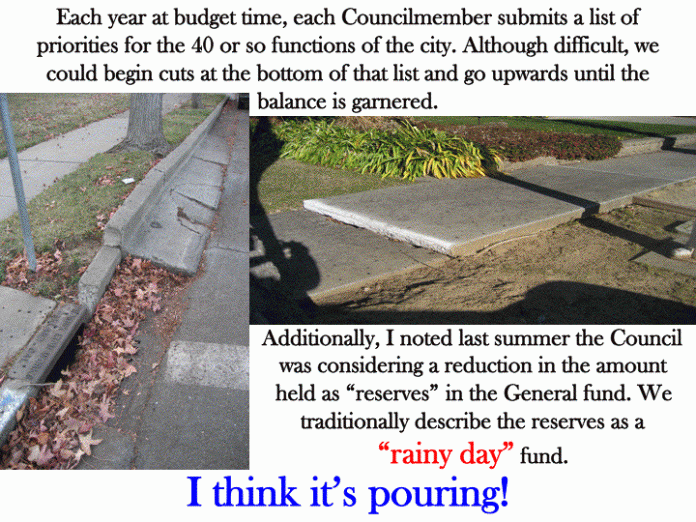Body to begin from square one after new members claim voter
mandate
– $10M bond idea floated
GILROY
Pointing to their seats on the dais as evidence of a voter mandate, the city council’s three newest members convinced the full body to scuttle the controversial sidewalk ordinance Monday night and begin anew, possibly by fixing the city’s $10-million sidewalk and gutter problem with a 30-year bond.
Councilman Peter Arellano and Mayor Al Pinheiro were reluctant to support the decision because of tight funds and the anti-bonding recommendations of a residential group who studied the city’s sidewalk problem for eight months in 2006. Those recommendations led to the now-dead ordinance that clarified residents’ responsibility to repair their sidewalks and assume partial liability for injuries sustained on them. The task force also buttressed the city’s “50-50” program, under which a resident with a damaged sidewalk splits the repair costs with the city, which has about $250,000 annually to do so.
But council members Bob Dillon, Perry Woodward, Cat Tucker and Craig Gartman – all of whom campaigned against residential responsibility for damaged sidewalks last year – repeatedly noted that trees the city requires residents to plant are tearing up the sidewalks, so why should they have to fix something a city tree broke?
“This is a complete and utter exercise in government arrogance,” Dillon said before his comical, yet straight-forward PowerPoint presentation that included a slide titled ‘Death to liquidambars!’ with a chain saw in the background. Liquidambar is the deciduous tree the city required residents to plant that has since wreaked havoc on concrete walkways, and the 50-50 program has largely become the solution, much to Dillon’s chagrin.
“We are (trying to) extract money from our citizens’ pockets for a problem we caused. If you want to see the results of this ordinance last summer, there are two new council members sitting on this dais,” Dillon said, referring to Woodward and Tucker because he sat on the council from 2001 to 2005. “This is 19th century technology confounding us in the 21st century… The problem is gone when the trees are gone, and I happen to know for a fact the city owns a couple of chain saws,” Dillon said.
Confusion arose last year over the fact that section 5610 of the state Streets and Highways Code says property owners must maintain their sidewalks in a safe, working condition, but they are not responsible for portions of the sidewalk damaged by “any person other than the owner” who has “a right granted to him by law or by the city authorities.” This means that city-protected, sidewalk-damaging trees – which have caused 90 percent of the problems, according to City Transportation Engineer Don Dey – are the culprits; the city made a mistake by requiring them, so now it needs to pay for the damage, according to Dillon and company.
“The state code presupposes that the city did not cause the problem (with the trees),” Woodward said. “The city as a whole benefits from all those trees, so the community should bear the expense associated with all those trees – not an individual homeowner.”
In an effort to strike an early compromise, Pinheiro floated the idea of having the city assume the full costs of tree maintenance and the curb and gutter, yet continue the 50-50 sidewalk program that has funded $2.7 million in sidewalk repairs since its inception in the early 1990s, according to former City Administrator Jay Baksa.
Later Gartman suggested having property owners perform the labor to repair their sidewalks while the city finances 100 percent of the materials. He also said the current council was paying for the tree-happy mistakes of previous councils and should rectify the situation, but former Planning Commissioner Tim Day warned the body that if it decides to assume tree-borne sidewalk liabilities, then it could set itself up for pettier claims.
“Are we going to take responsibility for shrubs (the city required a developer to build) tearing up the foundation of a house?” Day asked.
Regardless, Pinheiro said he wanted to keep the 50-50 program because the Sidewalk Task Force, which Dillon sat on as a resident, looked at all the issues.
“The task force did an excellent job. They looked at bonding versus non-bonding,” Pinheiro said. “If we bond now, we’ll have to bond again for the next round of repairs, and at some point and time, we’ll have to decide whether we’ll front the money or use the task force recommendations.”
Arellano vehemently agreed.
“If you want to tell the citizens they wasted their time, and we’re going to start from square one, then so be it,” Arellano said. “This was a task force of the citizens of Gilroy who are taxpayers, and they looked at everything we’re looking at. I want you all to understand that.”
The council never passed the sidewalk ordinance last year as controversy and the campaign creeped up, and it effectively died Monday night after Dillon said, “I hope everyone lives long enough to see the day I vote for this ordinance.” The ordinance did not include a section specifically addressing who is liable for sidewalk-related injuries, though city officials point to state code as supporting a shared liability between a resident and the municipality. City Attorney Linda Callon has said that if an accident occurs, a court will assess proportional liability.
Another ambiguity brought up Monday night was the seeming contradiction between the city’s sidewalk policy and its Street Tree Policy. The former says property owners must repair sidewalks that “are dangerous to the public health, safety and welfare of the inhabitants of the city.” The tree policy similarly “allows for street-tree removal when the tree presents a public safety hazard,” according to a report by Carla Ruigh, the city’s operations services manager. But “the [tree] policy does not allow for tree removal because of damage to sidewalks.”
Dillon said his $10 million bond idea – which could appear on the June 3 ballot if the city submits it to the registrar of voters by March 3 – would cost $600,000 to $900,000 per year for 30 years to repay, he said. He added that the city could use the 50-50 fund to kick-start repayment and also take a portion of tax revenue from new businesses.
The council will prioritize its spending for the upcoming fiscal year Feb. 25, and Dillon said the council should slash the list from the bottom up. Police and fire top the current fiscal year’s 43-item list, and cultural recreation programs, the museum, volunteer programs, alley improvements and special events ranked at the very bottom of the list. But don’t forget about the $27 million in reserves the city has for a rainy day, Dillon said.
“It’s pouring, folks. We need to fix this. Somebody is going to slip and sue our socks off,” Dillon said. “This is our most basic infrastructure, and when we get it done, then I will be happy to consider this ordinance” to ensure ongoing maintenance.
Slashing from the bottom up sounds easier than it is, Pinheiro said, though the council will figure it out Feb. 25.
“People will say, ‘Fix my sidewalks, but don’t cut my kids’ program,’ and so on,” Pinheiro said. “That’s when we all have to cut the baby up. That’s the day we balance everything.”













